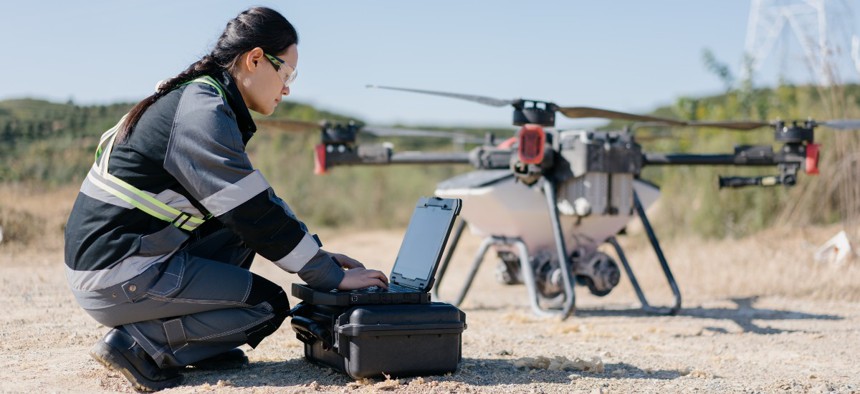FCC Releases Proposed Rule to Give Drones More Spectrum Access

sinology/Getty Images
As unmanned aircraft systems have increasingly versatile uses, the FCC wants comments on how best to share band access with more connected devices.
The Federal Communications Commission proposed new rules on Wednesday that would improve wireless communications on unmanned aircraft systems by allowing access to the 5 GHz band.
Building off a 2020 report advocating for UAS access to the 5030-5091 MHz licensed spectrum, FCC officials look to bolster the capabilities of UAS in critical missions, including disaster relief and consumer uses.
“It is past time that we assess the availability of wireless communications resources for the increasingly important remote-piloted aircraft activity we rely on today,” FCC Chairwoman Jessica Rosenworcel said Wednesday in a statement. “The FCC must ensure that our spectrum rules meet the current—and future—spectrum needs of evolving technologies such as unmanned aircraft systems, which can be critical to disaster recovery, first responder rescue efforts and wildfire management. I thank our colleagues at [the National Telecommunications and Information Administration]and [the Federal Aviation Administration] for their engagement on this proceeding, and I look forward to building a strong public record for this rulemaking.”
FCC officials are looking for input on the safety measures that may be necessary to help UAS operate across flexible-use wireless networks. The agency is also requesting comments on ensuring flexible-use spectrum bands could support aerial drones and devices as well as terrestrial operations without interference.
The rule additionally requires that UAS operators obtain a formal license to ensure compliance with current airspace law. This would further permit operators to communicate with air traffic control and other aircraft within the spectrum band.
Commissioner Geoffrey Starks voiced support for the FCC’s proposed rule, noting that regulatory action on behalf of the agency can help the industry grow and maintain U.S. leadership in UAS and drone standards.
“UAS technologies pose plenty of potential, and their promise goes well beyond just package deliveries,” he said. “We’re right to continue supporting their development, even as we also explore the unique policy challenges posed by their operation.”
The federal government has long considered introducing UAS to the 5030-5091 MHz spectrum band, with Congress mandating research and analysis from the FCC and FAA regarding drone operations on licensed spectrum bands as part of the FAA Reauthorization Act of 2018.
Interference with other networks is the primary concern for permitting UAS access to the spectrum band, particularly with increased business and consumer needs. The congressionally mandated report supported access to the 5030-5091 MHz band, and raised concerns over the proposed access to the 960-1164 MHz band.
CTIA, a leading trade organization involved in the broadband and wireless communications industries, said in an October 2021 document that the FCC should consider several factors in UAS-spectrum rulemaking, including clarifying that a variety of spectrum bands will work for UAS operations.
“The Commission should recognize that UAS deployments will rely heavily upon commercial wireless spectrum and networks,” CTIA officials said. “Safe UAS operations depend on reliable, secure, nationwide communications over licensed spectrum.”



